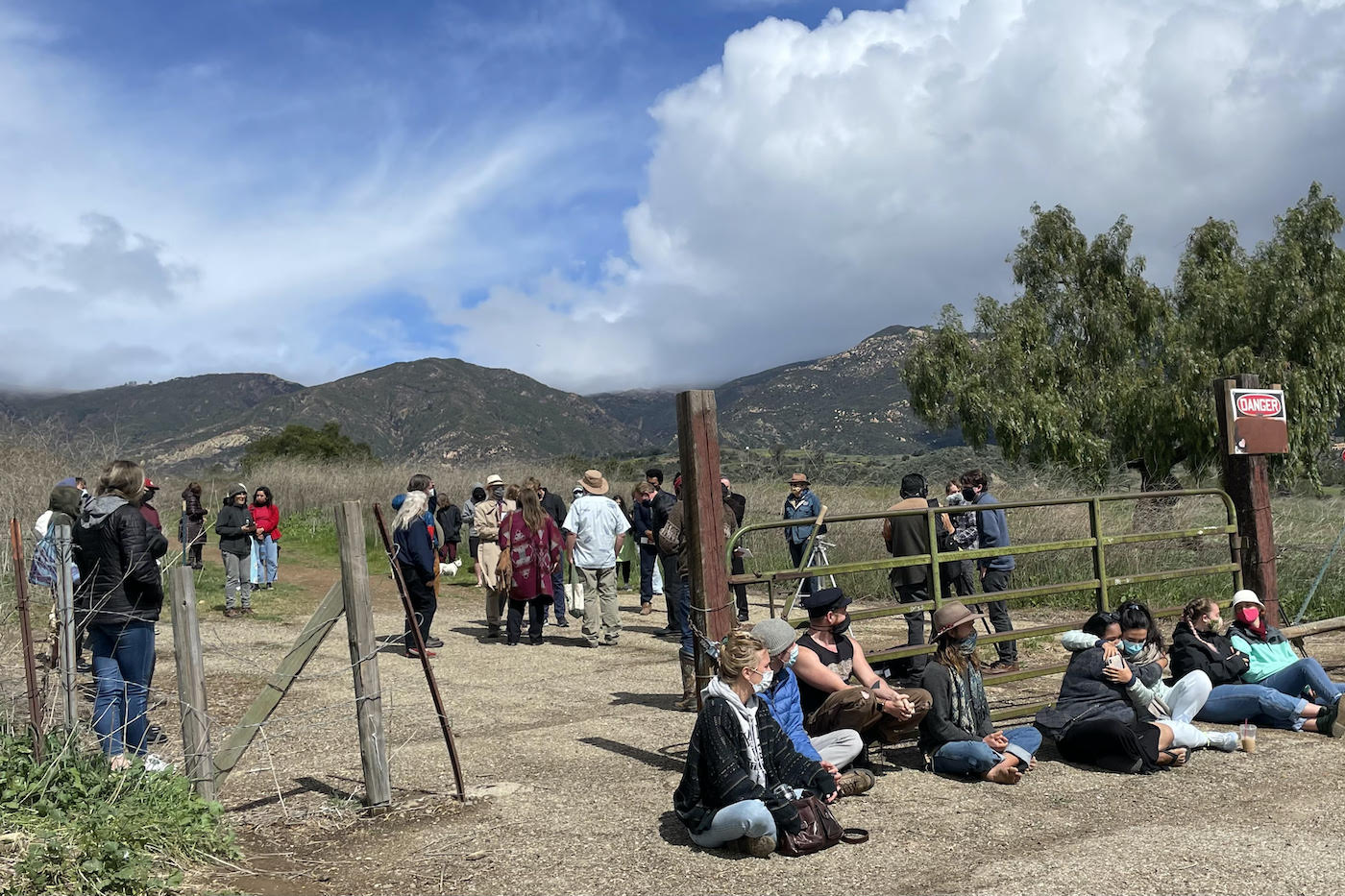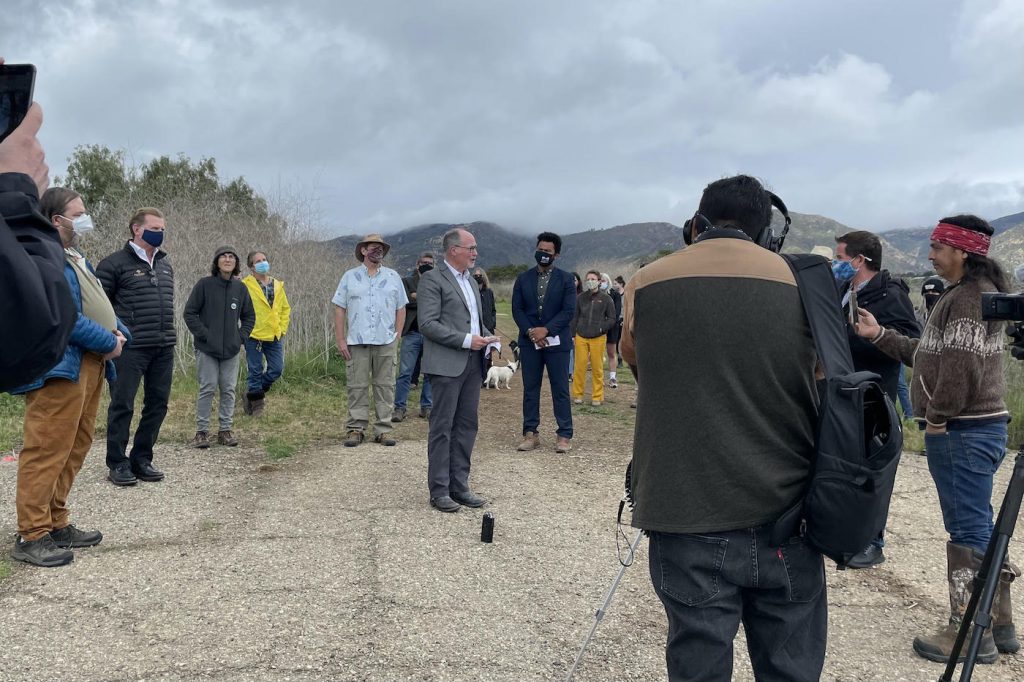San Marcos Foothills: Rich in History

Julie Cordero-Lamb is an ethnobotanist and a member of the Coastal Band of the Chumash Nation. She joined the effort to protect San Marcos Foothills nearly twenty years ago. She has a unique perspective on the site, which is important to her and to the Chumash community. “We have a connection to that place that goes back 15,000 years,” said Cordero-Lamb. “You can’t put a price on that.”
Cordero-Lamb, who is in her 40s, has studied indigenous plant medicine. She received her B.A. in anthropology from Evergreen State College and her M.A. in religious studies from UCSB. She founded the Syuxtun Plant Mentorship Collective to spread that knowledge, naming the group after a large Chumash village that existed in 1542, according to historical accounts. Cordero-Lamb’s work with the collective has been featured on the PBS SoCal and other news outlets.
Because the Coastal Band of the Chumash Nation is a non-federally recognized tribe, it does not have a formal say in what happens to its ancestral lands here. Even so, the area holds cultural and spiritual significance for the band, explained Cordero-Lamb. “When a lot of our young people need to pray, this is where they come.”
According to her, the hills of San Marcos contain “the last slice of perennial oak grasslands in Santa Barbara.” Centuries ago, the Chumash people came to these grasslands to gather acorns, grass and materials to make their baskets. Every few years, they burned the hills as a way to manage wildfires.
Today, Cordero-Lamb, members of her plant collective and other tribal people still collect seeds and herbs here, just as their ancestors once did. (Chumash artifacts used for food processing have been found at two locations here.) The land still provides food, medicine, and supplies for traditional crafts.
“This type of ecosystem is really rare,” said Cordero-Lamb. It contains chaparral, coastal sage scrub, coast live oak woodlands, arroyo willow/coast live oak riparian woodlands, coast live oak savanna, native perennial grasslands, as well as non-native annual grassland.
When settlers emigrated here from Spain, Mexico, and America’s eastern front, they pushed out the native people and turned the grasslands into fruit orchards, cattle ranches, sheep granges, and dairies. By 1915, the Flying A Studios of Santa Barbara occasionally used the rolling hills as a backdrop for films.
After World War II, according to Channel Islands Restoration, single-family housing was developed on parts of the property, while other parts were deeded to the state for road widening. In 1998, a proposal to develop an equestrian-themed community was denied approval and, suddenly, the area became the focus of preservationists.
In 1996, the community rallied to protect the land, and Brooke Bulkley and Mark Holmgren formed the San Marcos Foothills Coalition (SMFC) to protect the area’s open space. By 1999, more than a dozen community organizations and people had joined the coalition, including Cordero-Lamb. Even so, the developer bought 315 acres and donated 90% of it to what is now called the San Marcos Foothills Preserve. With that transfer, the county approved Chadmar’s small development of elegant homes.
But building more houses would be detrimental to the foothills and the surrounding ecosystem, said Cordero-Lamb. This is home to dozens of sensitive species including Townsend’s big-eared bat; the San Diego black-tailed jackrabbit, and the American badger. Construction not only destroys the natural habitat of these and other creatures, it creates automobile traffic, noise pollution and light pollution, which harms wildlife. It displaces smaller prey animals, such as rabbits, which causes predator species, such as white-tailed kites, to leave the area in search of a more plentiful food source. Construction can also block wildlife from using migratory routes that their species have used for centuries.
The foothills – and its homes – lie in a high-risk fire zone, and are threatened by drought and future water shortages. And even luxury homeowners use toxic chemicals and pesticides on their property, which impacts land far beyond their own. “That affects everything around it,” said Cordero-Lamb.
Today, wealthy donors and community donations are the last hope for those who call themselves land defenders.
Protests, Arrests, and an $18 Million Offer

In late February, the winter sun rose on the San Marcos Foothills and illuminated a make-shift camp of 30 people. Members of the group sang ancient songs and chanted Chumash prayers on land that for centuries had been a gathering place for tribal members. The purpose of the group was to try and save the remaining acres of space, which was owned by a developer, The Chadmar Group.
As the day progressed, about 100 people came and went. The protestors included college students, environmentalists, neighbors, and local indigenous people. They had brought with them a table to register volunteers; folding chairs; blankets; tents and coolers of food and refreshments. Many people stood at the entrance to the building site; some had tied themselves to the fence to try and stop construction workers who were simply doing their job.
But the developer and its contractors were frustrated as they were ready to finish the final phase of development. The sheriffs were called, and the conflict escalated.
Tension grew between the protestors, some of whom were arrested and said they were roughly treated, and sheriff deputies, who were trying to allow the permitted construction to proceed.
One could say that the battle brought the two sides together. Last week, the developer and environmentalists announced that they had forged an agreement. For the following 90 days, the protestors would leave the building site and the developer would stop his bulldozers. Chadmar would give the Save San Marcos Foothills group time to raise about $18 million to buy the remaining acres from the developer. (See the interview with developer Charles Lande.)
If the group fails to raise $18 million, it has pledged to stop blocking the construction. If it reaches its goal, it could prove to be a win-win for both developer and protestors. No matter what, the incident in the hills underlines how tough it can be to develop even a small, preservation-friendly site in Santa Barbara, home to the environmental movement.
Here’s how the truce played out:
Although some protestors may not have realized it, the developer in December 2006 had owned 350 acres. It agreed to give 315 acres to the county in exchange for approval to build 20 homes on the remaining 35 acres. The deal had allowed the owner to build 15 market-rate, luxury homes and five affordable ones. Of the 315 donated acres, some 200 acres created the San Marcos Foothill Preserve; another 16 acres were given to the public for a county park; and 98 acres were set aside as a preserved open space that would remain private.
On October 2017, the County Parks Department asked community members to submit input ideas for the “San Marcos Park” Master Plan. The department held four public workshops and posted a survey on its website. It reportedly had submitted a conceptual plan to the County Parks Commission in late 2017.
Some construction had started in 2014; a little more work took place about three years later. At that point, ten of the 20 homes had been completed and most of them were occupied.
But the neighbors, joggers, and walkers who used the preserve hadn’t seen much of this activity. Protestor Shayne Casso had been taking weekly walks at the San Macros Preserve for a while. “I just love being here,” she told the Montecito Journal. College student and protestor Emily Hoeflinger had hiked the area with her family as a girl. “It’s just a really special place.”
Indeed, members of the preservation group believed that the housing development had either died or been stalled due to high building costs or some other factor. Then, someone noticed a sign; another spied machinery. In the summer of 2020, four women founded the nonprofit group called Save the San Marcos Foothills and set about galvanizing the community.
They began asking for donations in order to buy the land that was being developed, said Nancy Tubiolo, one of the cofounders. (The other founders are Dani Lynch, Samantha Eddy, and Julia Laraway.) The group managed to collect about $1.3 million. But they knew that they would have to raise many times that amount in order to make a legitimate offer on the property.
“If we don’t do anything, then nothing will happen.”
So, in late February, the group announced to its 7,000 Instagram followers and some 500 Facebook friends that it was hosting a sit-in to protest the housing development. That’s when streams of young people and seasoned environmentalists started setting up camp and mounting peaceful protests.
On the morning of February 25, 2021, things came to a boil. Sheriffs arrested eight protestors – half of whom were indigenous women. That escalated the tension as many protestors objected. Sheriffs said that the demonstrators were arrested on suspicion of violating two sections of the California penal code: one that prohibits a person from blocking a contractor from gaining access to a site; and another forbids one from obstructing the free movement of another.
One indigenous woman who was arrested, Noemi Aidee Tungui, described her experience on a public Facebook page. “Three SB sheriffs violently arrested me in a crowd of white folks. We were not read our rights or told why we were being arrested.” She said that two big white deputies “twisted my arms so violently that my hands, arms, and eye remain cut (and) bruised.”
Isa Saldivar, another indigenous protestor in her early 20s, was also arrested. She said that “just our presence was a threat to (the sheriffs).”
Deputies loaded the protestors into a van and drove them to the Santa Barbara County jail on Calle Real. The Montecito Journal followed them.
When the women and other suspects arrived at the jail, Tungui said that she saw some deputies first-bump one another in a gesture of congratulations. “(T)hey pointed at us and laughed,” she wrote on Facebook.
She said that sheriffs tried to remove face jewelry from the women. Tungui added that she had asked the sheriff to sanitize his hands before he touched her or her jewelry. When the officer couldn’t remove her adornments, he let her wear them.
Deputies placed a small indigenous woman in a cell alone, Tungui said. Tungui herself was placed in a room crammed with other protestors and next to women who were suffering from mental-health issues. It was so crammed that Tungui said she had to sit on a urine-stained floor.
Meanwhile, outside the jail, about two dozen protestors had arrived to show their support. People huddled under trees to shade themselves from the sun; others tried to talk to deputies. They waited for several hours.
Then, the first suspect was released from jail. The waiting crowd cheered. A few people outside the jail sang traditional Chumash songs, played guitar, and clapped. That afternoon, an elderly man, three younger men, and the four indigenous women were set free; some were crying; all were applauded by their fellow activists.
The incident prompted the two sides to come together and negotiate a 90-day peace agreement. After the announcement of the truce, the nonprofit raised a total of $1.7 million. “We’ve had an outpouring of support and continue to grow based on small to midsize donations,” said Tubiolo.
“What will push us to our goal are bigger donors.”
Meanwhile, the sheriff’s department has dropped all charges against the eight protestors it arrested. Save San Marcos Foothills is trying to meet its first benchmark on March 24, when it must raise an additional $4 million – and keep on raising money until they have $18 million.
Saldivar, one of the indigenous women and arrestees, said she is undeterred. “We’re not going to stop fighting for the land, so you might as well join us.”
Additional reporting by K. Sharp.







